2006 SUBARU TRIBECA wheel size
[x] Cancel search: wheel sizePage 277 of 377

9-6 In case of emergency
Temporary spare tire
The temporary spare tire is smaller and
lighter than a conventional tire and is de-
signed for emergency use only. Remove
the temporary spare tire and re-install the
conventional tire as soon as possible be-
cause the spare tire is designed only for
temporary use.
Check the inflation pressure of the tempo-
rary spare tire periodically to keep the tire
ready for use. The correct pressure is 60
psi (420 kPa, 4.2 kgf/cm 2
).
When using the temporary spare tire, note
the following.�y Do not exceed 50 mph (80 km/h).
�y Do not put a tire chain on the temporary
spare tire. Because of the smaller tire
size, a tire chain will not fit properly. �y Do not use two or more temporary
spare tires at the same time. �y Do not drive over obstacles. This tire
has a smaller diameter, so road clearance
is reduced. 1) Tread wear indicator bar
2) Indicator location mark
�y When the wear indicator appears on the
tread, replace the tire. �y The temporary spare tire must be used
only on a rear wheel. If a front wheel tire
gets punctured, replace the wheel with a
rear wheel and install the temporary spare
tire in place of the removed rear wheel.
�y Never tow a trailer when the tem-
porary spare tire is used. The tem-
porary spare tire is not designed
to sustain the towing load. Use of
the temporary spare tire when
towing can result in failure of the
spare tire and/or less stability of
the vehicle and may lead to an ac-
cident.
�yWhen a spare tire is mounted or a
wheel rim is replaced without the
original pressure sensor/trans-
mitter being transferred, the low
tire pressure warning light will
flash. This indicates the tire pres-
sure monitoring system (TPMS) is
unable to monitor all four road
wheels. Contact your SUBARU
dealer as soon as possible for tire
and sensor replacement and/or
system resetting.
Never use any temporary spare tire
other than the original. Using other
sizes may result in severe mechani-
cal damage to the drive train of your
vehicle.1
2
900209
Page 281 of 377
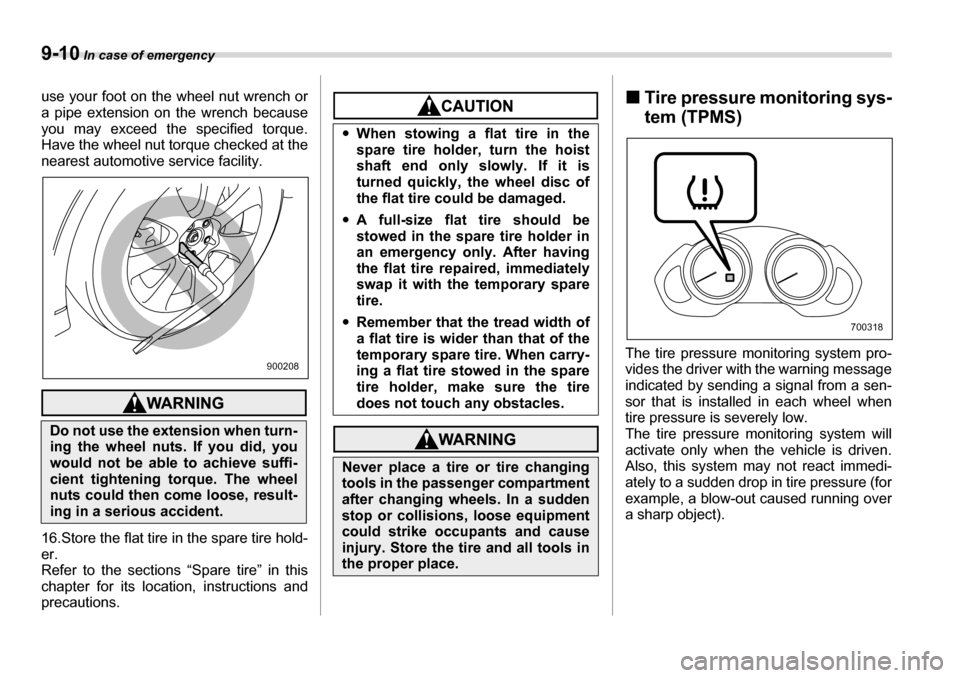
9-10 In case of emergency
use your foot on the wheel nut wrench or
a pipe extension on the wrench because
you may exceed the specified torque.
Have the wheel nut torque checked at the
nearest automotive service facility.
16.Store the flat tire in the spare tire hold- er.
Refer to the sections “Spare tire” in this
chapter for its location, instructions and
precautions.
�„Tire pressure monitoring sys- tem (TPMS)
The tire pressure monitoring system pro-
vides the driver with the warning message
indicated by sending a signal from a sen-
sor that is installed in each wheel when
tire pressure is severely low.
The tire pressure monitoring system will
activate only when the vehicle is driven.
Also, this system may not react immedi-
ately to a sudden drop in tire pressure (for
example, a blow-out caused running over
a sharp object).
Do not use the extension when turn-
ing the wheel nuts. If you did, you
would not be able to achieve suffi-
cient tightening torque. The wheel
nuts could then come loose, result-
ing in a serious accident.
900208
�y When stowing a flat tire in the
spare tire holder, turn the hoist
shaft end only slowly. If it is
turned quickly, the wheel disc of
the flat tire could be damaged.
�y A full-size flat tire should be
stowed in the spare tire holder in
an emergency only. After havingthe flat tire repaired, immediately
swap it with the temporary spare tire.
�y Remember that the tread width of
a flat tire is wider than that of the
temporary spare tire. When carry-
ing a flat tire stowed in the spare
tire holder, make sure the tire
does not touch any obstacles.
Never place a tire or tire changing
tools in the passenger compartment
after changing wheels. In a sudden
stop or collisions, loose equipment
could strike occupants and cause
injury. Store the tire and all tools in
the proper place.
700318
Page 294 of 377
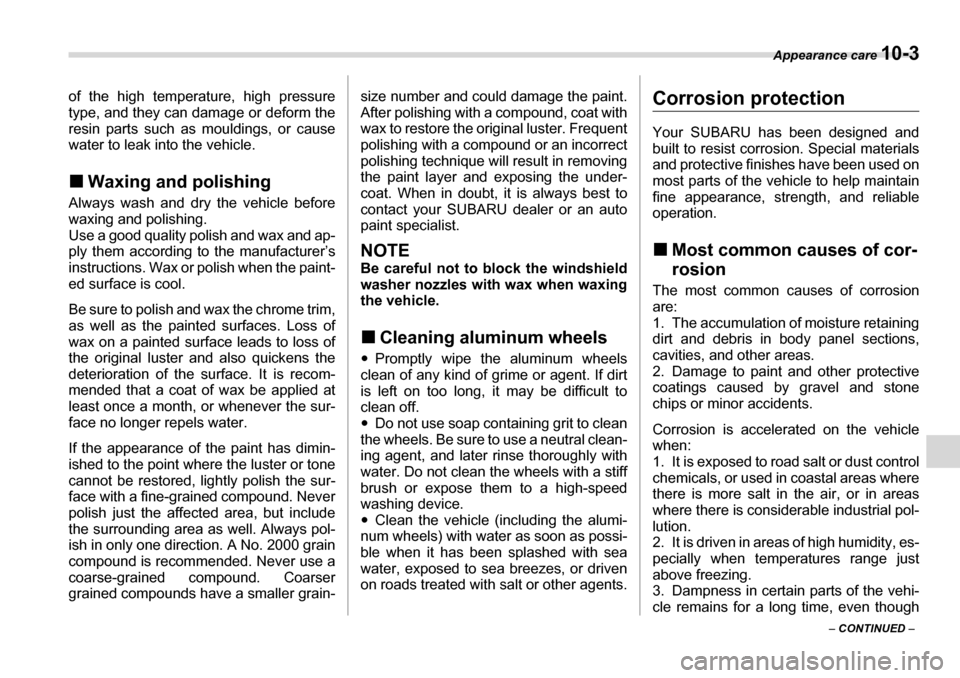
Appearance care 10-3
– CONTINUED –
of the high temperature, high pressure
type, and they can damage or deform the
resin parts such as mouldings, or cause
water to leak into the vehicle. �„
Waxing and polishing
Always wash and dry the vehicle before
waxing and polishing.
Use a good quality polish and wax and ap-
ply them according to the manufacturer’s
instructions. Wax or polish when the paint-
ed surface is cool.
Be sure to polish and wax the chrome trim,
as well as the painted surfaces. Loss of
wax on a painted surface leads to loss of
the original luster and also quickens the
deterioration of the surface. It is recom-
mended that a coat of wax be applied at
least once a month, or whenever the sur-
face no longer repels water.
If the appearance of the paint has dimin-
ished to the point where the luster or tone
cannot be restored, lightly polish the sur-
face with a fine-grained compound. Never
polish just the affected area, but include
the surrounding area as well. Always pol-
ish in only one direction. A No. 2000 grain
compound is recommended. Never use a
coarse-grained compound. Coarser
grained compounds have a smaller grain- size number and could damage the paint.
After polishing with a compound, coat with
wax to restore the original luster. Frequent
polishing with a compound or an incorrect
polishing technique will result in removing
the paint layer and exposing the under-
coat. When in doubt, it is always best to
contact your SUBARU dealer or an auto
paint specialist.
NOTE
Be careful not to block the windshield
washer nozzles with wax when waxing
the vehicle. �„
Cleaning aluminum wheels
�y Promptly wipe the aluminum wheels
clean of any kind of grime or agent. If dirt
is left on too long, it may be difficult to
clean off. �y Do not use soap containing grit to clean
the wheels. Be sure to use a neutral clean-
ing agent, and later rinse thoroughly with
water. Do not clean the wheels with a stiff
brush or expose them to a high-speedwashing device. �y Clean the vehicle (including the alumi-
num wheels) with water as soon as possi-
ble when it has been splashed with sea
water, exposed to sea breezes, or driven
on roads treated with salt or other agents.
Corrosion protection
Your SUBARU has been designed and
built to resist corrosion. Special materials
and protective finishes have been used on
most parts of the vehicle to help maintain
fine appearance, strength, and reliable
operation. �„ Most common causes of cor- rosion
The most common causes of corrosion
are:
1. The accumulation of moisture retaining
dirt and debris in body panel sections,
cavities, and other areas.
2. Damage to paint and other protective
coatings caused by gravel and stone
chips or minor accidents.
Corrosion is accelerated on the vehicle
when:
1. It is exposed to road salt or dust control
chemicals, or used in coastal areas where
there is more salt in the air, or in areas
where there is considerable industrial pol-
lution.
2. It is driven in areas of high humidity, es-
pecially when temperatures range just
above freezing.
3. Dampness in certain parts of the vehi-
cle remains for a long time, even though
Page 325 of 377
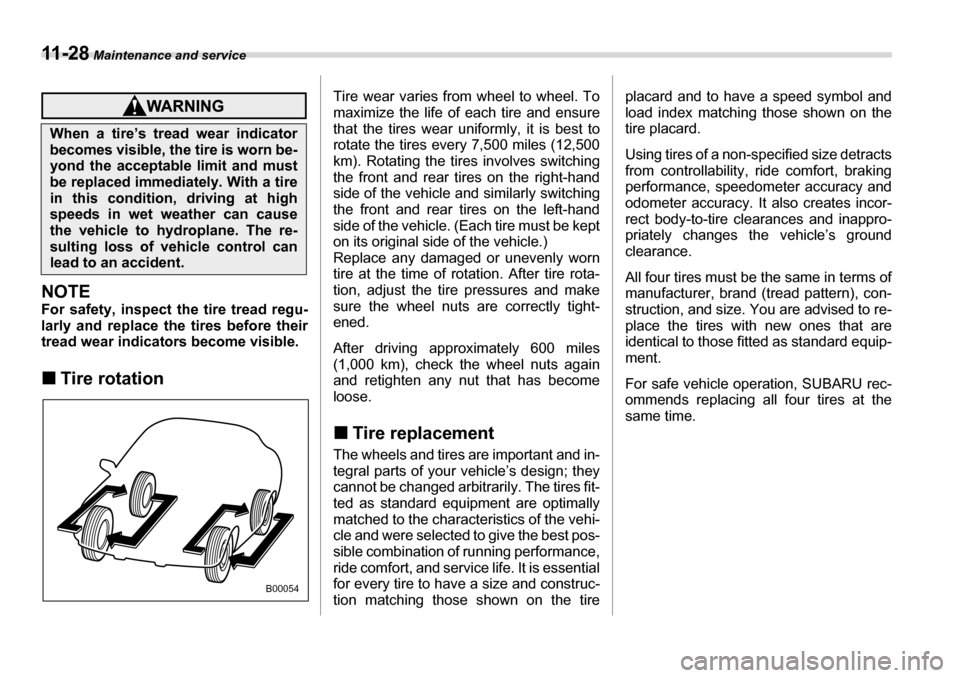
11 - 2 8 Maintenance and service
NOTE
For safety, inspect the tire tread regu-
larly and replace the tires before their
tread wear indicators become visible. �„Tire rotation Tire wear varies from wheel to wheel. To
maximize the life of each tire and ensure
that the tires wear uniformly, it is best to
rotate the tires every 7,500 miles (12,500
km). Rotating the tires involves switching
the front and rear tires on the right-hand
side of the vehicle and similarly switching
the front and rear tires on the left-hand
side of the vehicle. (Each tire must be kept
on its original side of the vehicle.)
Replace any damaged or unevenly worn
tire at the time of rotation. After tire rota-
tion, adjust the tire pressures and make
sure the wheel nuts are correctly tight-
ened.
After driving approximately 600 miles
(1,000 km), check the wheel nuts again
and retighten any nut that has become
loose. �„
Tire replacement
The wheels and tires are important and in-
tegral parts of your vehicle’s design; they
cannot be changed arbitrarily. The tires fit-
ted as standard equipment are optimally
matched to the characteristics of the vehi-
cle and were selected to give the best pos-
sible combination of running performance,
ride comfort, and service life. It is essential
for every tire to have a size and construc-
tion matching those shown on the tire placard and to have a speed symbol and
load index matching those shown on the
tire placard.
Using tires of a non-specified size detracts
from controllability, ride comfort, braking
performance, speedometer accuracy and
odometer accuracy. It also creates incor-
rect body-to-tire clearances and inappro-
priately changes the vehicle’s groundclearance.
All four tires must be the same in terms of
manufacturer, brand (tread pattern), con-
struction, and size. You are advised to re-
place the tires with new ones that are
identical to those fitted as standard equip-
ment.
For safe vehicle operation, SUBARU rec-
ommends replacing all four tires at the same time.
When a tire’s tread wear indicator
becomes visible, the tire is worn be-
yond the acceptable limit and must
be replaced immediately. With a tire
in this condition, driving at high
speeds in wet weather can cause
the vehicle to hydroplane. The re-
sulting loss of vehicle control can
lead to an accident.
B00054
Page 326 of 377
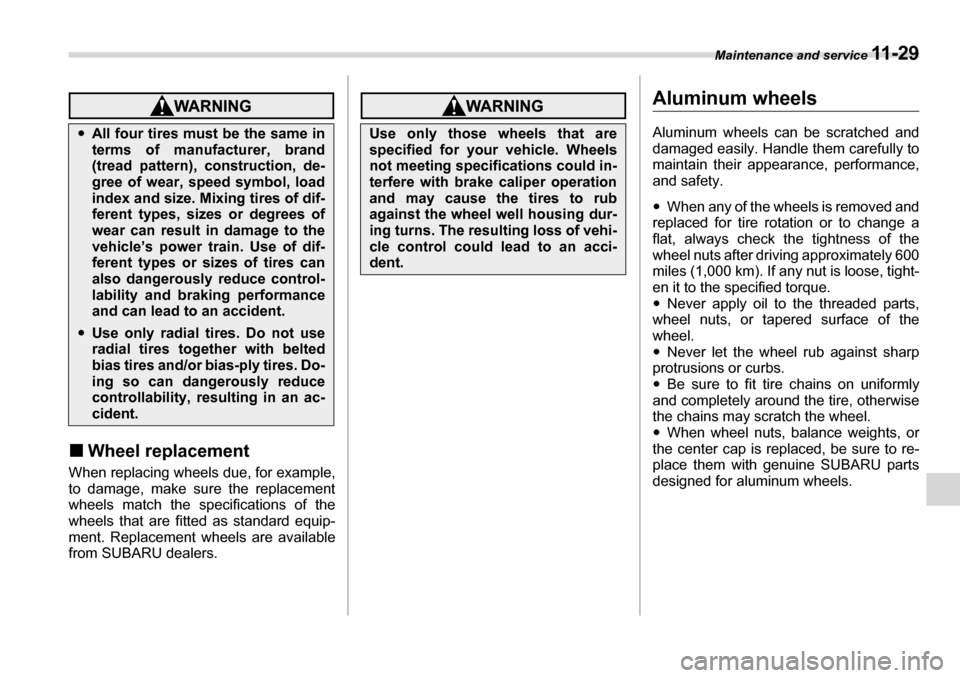
Maintenance and service 11 - 2 9
�„Wheel replacement
When replacing wheels due, for example,
to damage, make sure the replacement
wheels match the specifications of the
wheels that are fitted as standard equip-
ment. Replacement wheels are available
from SUBARU dealers.
Aluminum wheels
Aluminum wheels can be scratched and
damaged easily. Handle them carefully to
maintain their appearance, performance,
and safety. �y When any of the wheels is removed and
replaced for tire rotation or to change a
flat, always check the tightness of the
wheel nuts after driving approximately 600
miles (1,000 km). If any nut is loose, tight-
en it to the specified torque.�y Never apply oil to the threaded parts,
wheel nuts, or tapered surface of the
wheel.�y Never let the wheel rub against sharp
protrusions or curbs.�y Be sure to fit tire chains on uniformly
and completely around the tire, otherwise
the chains may scratch the wheel. �y When wheel nuts, balance weights, or
the center cap is replaced, be sure to re-
place them with genuine SUBARU parts
designed for aluminum wheels.
�y All four tires must be the same in
terms of manufacturer, brand
(tread pattern), construction, de-
gree of wear, speed symbol, load
index and size. Mixing tires of dif-
ferent types, sizes or degrees of
wear can result in damage to the
vehicle’s power train. Use of dif-
ferent types or sizes of tires can
also dangerously reduce control-
lability and braking performance
and can lead to an accident.
�yUse only radial tires. Do not use
radial tires together with belted
bias tires and/or bias-ply tires. Do-
ing so can dangerously reduce
controllability, resulting in an ac-
cident.
Use only those wheels that are
specified for your vehicle. Wheels
not meeting specifications could in-
terfere with brake caliper operation
and may cause the tires to rub
against the wheel well housing dur-
ing turns. The resulting loss of vehi-
cle control could lead to an acci-
dent.
Page 346 of 377
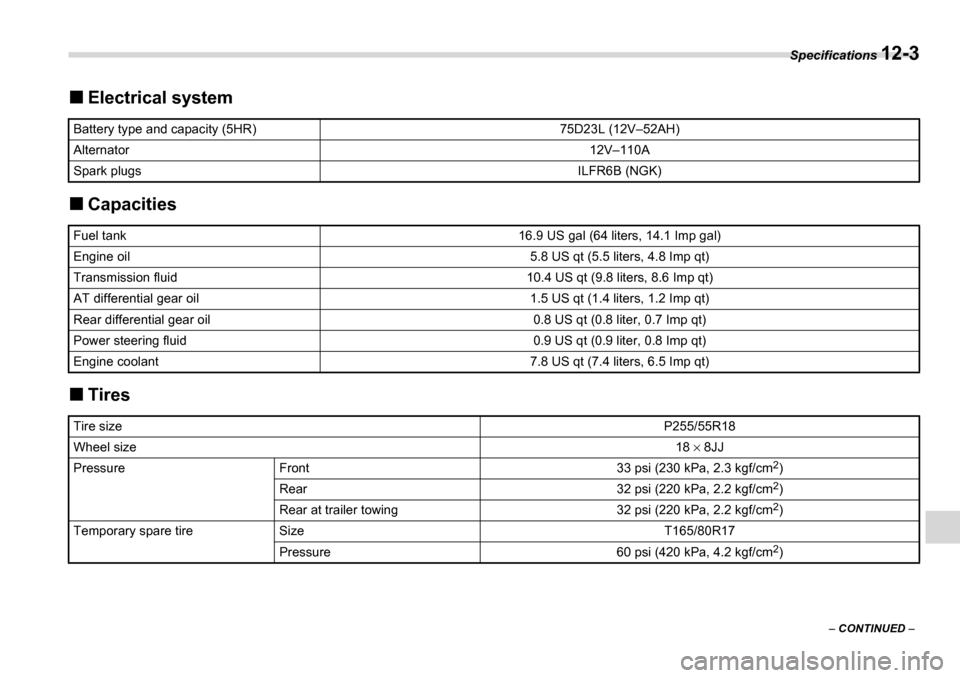
Specifications 12-3
– CONTINUED –
�„Electrical system
�„ Capacities
�„ Tires
Battery type and capacity (5HR)75D23L (12V–52AH)
Alternator12V–110A
Spark plugsILFR6B (NGK)
Fuel tank16.9 US gal (64 liters, 14.1 Imp gal)
Engine oil5.8 US qt (5.5 liters, 4.8 Imp qt)
Transmission fluid10.4 US qt (9.8 liters, 8.6 Imp qt)
AT differential gear oil1.5 US qt (1.4 liters, 1.2 Imp qt)
Rear differential gear oil0.8 US qt (0.8 liter, 0.7 Imp qt)
Power steering fluid0.9 US qt (0.9 liter, 0.8 Imp qt)
Engine coolant7.8 US qt (7.4 liters, 6.5 Imp qt)
Tire sizeP255/55R18
Wheel size18 × 8JJ
PressureFront33 psi (230 kPa, 2.3 kgf/cm 2
)
Rear32 psi (220 kPa, 2.2 kgf/cm 2
)
Rear at trailer towing32 psi (220 kPa, 2.2 kgf/cm 2
)
Temporary spare tireSizeT165/80R17
Pressure60 psi (420 kPa, 4.2 kgf/cm 2
)
Page 358 of 377
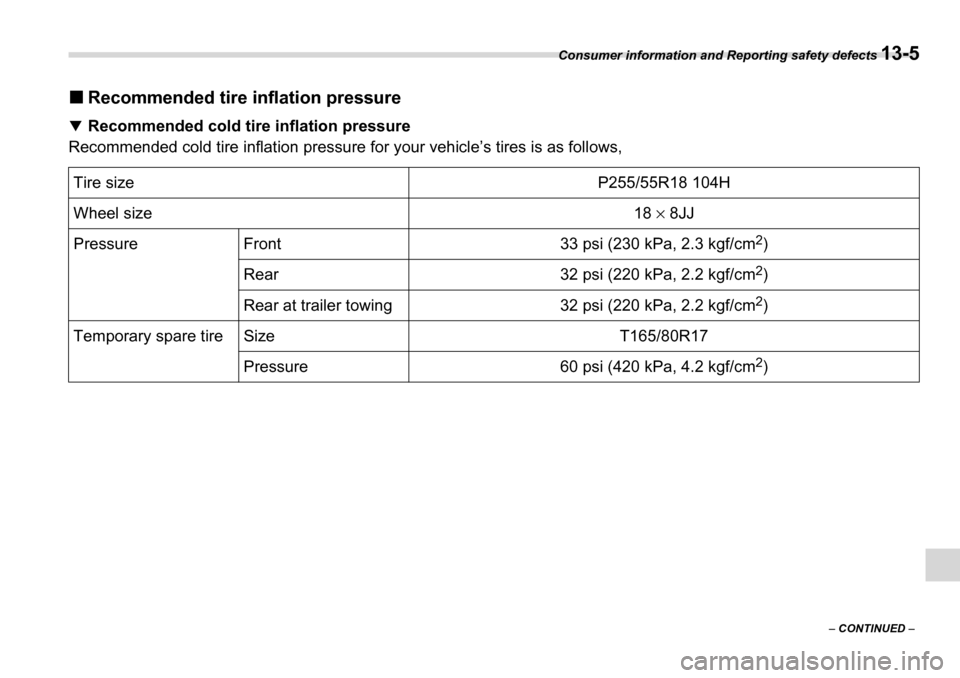
Consumer information and Reporting safety defects 13-5
– CONTINUED –
�„Recommended tire inflation pressure
�T Recommended cold tire inflation pressure
Recommended cold tire inflation pressure for your vehicle’s tires is as follows,
Tire sizeP255/55R18 104H
Wheel size18 × 8JJ
PressureFront33 psi (230 kPa, 2.3 kgf/cm 2
)
Rear32 psi (220 kPa, 2.2 kgf/cm 2
)
Rear at trailer towing32 psi (220 kPa, 2.2 kgf/cm 2
)
Temporary spare tireSizeT165/80R17
Pressure60 psi (420 kPa, 4.2 kgf/cm 2
)
Page 377 of 377

GAS STATION REFERENCE
Fuel:
Use premium unleaded gasoline with an octane rating of 91 AKI or
higher. For temporary purposes if premium unleaded gasoline is
not available, you may use regular unleaded gasoline with an oc-
tane rating of 87 AKI or higher. For optimum engine performance
and driveability, it is recommended that you use premium grade
unleaded gasoline. �„Fuel octane rating
This octane rating is the average of the Research Octane and Mo-
tor Octane numbers and is commonly referred to as the Anti Knock
Index (AKI). Refer to “Fuel” section in this manual. Fuel capacity:
16.9 US gal (64 liters, 14.1 Imp gal) Engine oil:
Use only API classification SM with the words “ENERGY CON-
SERVING” and the ILSAC certification mark (starburst mark) dis-
played on the container.
Engine oil capacity:
5.8 US qt (5.5 liters, 4.8 Imp qt)
Cold tire pressure: Tire size P255/55R18 104H
Wheel size 18 × 8JJ
Pressure Front 33 psi (230 kPa, 2.3 kgf/cm2
)
Rear 32 psi (220 kPa, 2.2 kgf/cm2
)
Rear at trailer towing 32 psi (220 kPa, 2.2 kgf/cm2
)
Temporary spare tire Size T165/80R17
Pressure 60 psi (420 kPa, 4.2 kgf/cm2
)